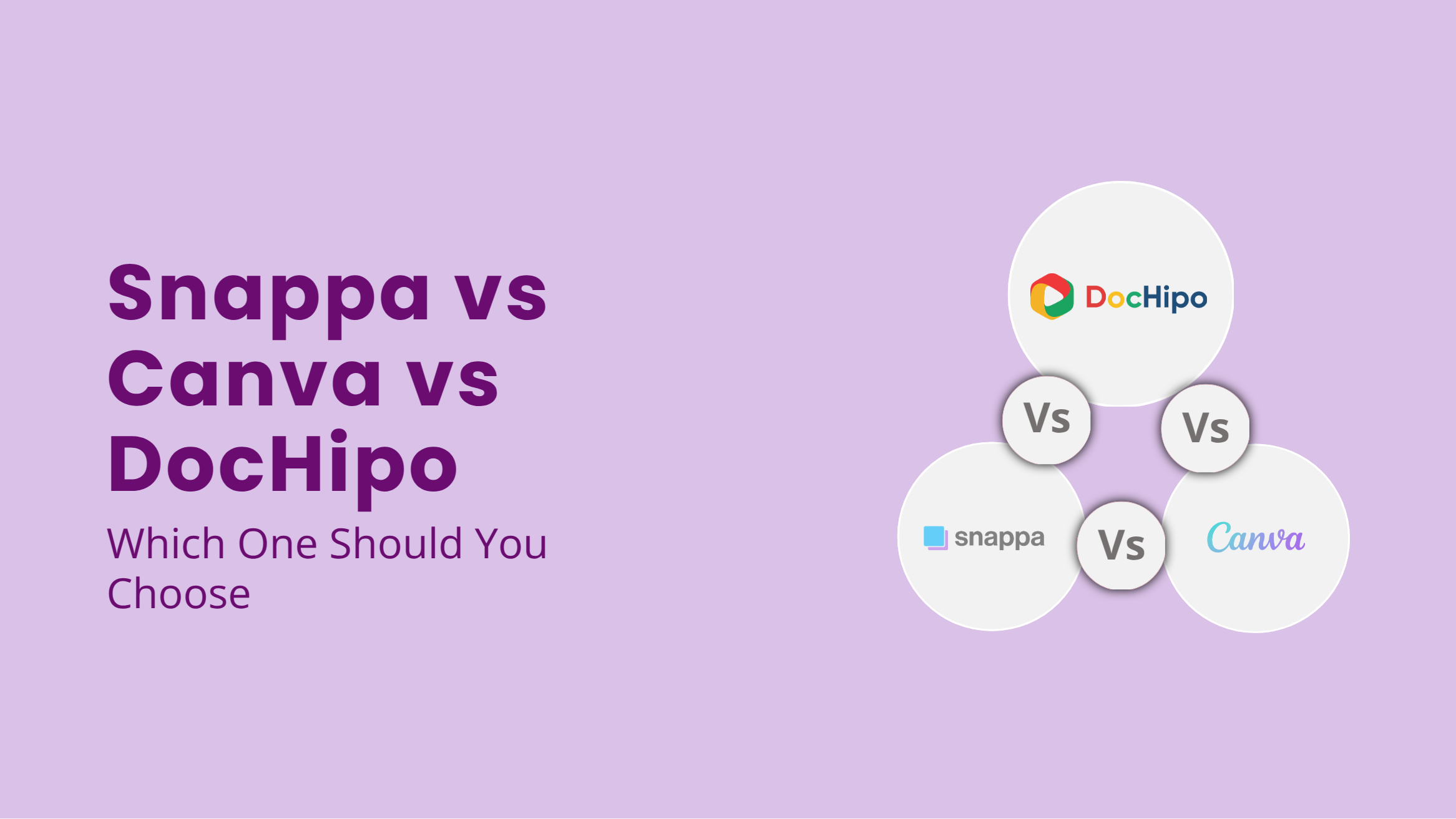
Snappa vs Canva vs DocHipo: Which One Should You Choose

If you’ve ever needed to create a quick social media post or X/Twitter ad, chances are you’ve come across tools like Snappa or Canva. But with each tool offering its features, templates, and style, how do you know which one to go for? That’s precisely what we’re here to figure out.
In this post, we’ll break down features of Snappa and Canva, and add one more design tool with ever-expanding assets – DocHipo. So let’s see the feature-by-feature comparison of Snappa vs Canva vs DocHipo.
Snappa vs Canva vs DocHipo
- Snappa: It is suitable for users looking for a quick and easy design tool with basic customization capabilities to design content for online platforms.
- Canva: It is best for marketers, agencies, businesses, and creators who are looking for a versatile tool to help them with designing, branding, and scheduling.
- DocHipo: If you’re looking for a clean, budget-friendly design tool that makes it easy for you or your team to create on-brand visuals, this one’s a great pick. Perfect for solopreneurs, startups, small businesses, and marketers who want a business-ready design without the hassle.
With hands-on experience on each tool, we have brought this comparative analysis of Snappa, Canva, and DocHipo. We have covered user interface, templates, design capabilities, and pricing.
Table of Contents
- What is Snappa
- What is Canva
- What is DocHipo
- Interface: User friendliness and Accessibility
- Templates: Quality, Category, and Aesthetics
- Design Assets: Snappa vs Canva vs DocHipo
- Data Visualization: Canva vs Snappa vs DocHipo
- Core Design Features: Snappa vs Canva vs DocHipo
- Sharing and Downloading Options
- AI Capabilities: Snappa vs Canva vs DocHipo
- Apps and Integrations for Seamless Workflow
- Pricing: Snappa vs Canva vs DocHipo
- Suitability: Canva vs Snappa vs DocHipo
- FAQs
What is Snappa
Snappa is a quick and easy graphic design tool for designing web content. It is one of the most hassle-free Canva alternatives, primarily catering to beginners with no prior design experience. You can create blog images, social media posts, ads, and more in just a few clicks. It’s ideal for solopreneurs, small businesses, and marketers who want pro-level visuals without the stress.
What is Canva
Canva is a one-stop platform for everything from designing to scheduling. It offers a wide range of templates, assets, and advanced design features. Overall, Canva is extravagant with numerous capabilities, including AI tools, and is ideal for creating various types of designs.
What is DocHipo
In comparison to Canva, DocHipo is a minimalist yet robust graphic design tool that helps you create business-focused designs. As an alternative to Snappa, the tool prioritizes ease of use for quick on-brand designs, while also offering a range of advanced features.
Now, let’s compare Snappa vs Canva vs DocHipo to find more about their exclusive features.
Interface: User friendliness and Accessibility
First, we will explore the interface of each tool. While checking the interface, we will focus on how the tool interacts with the user.
Snappa
Snappa’s dashboard is clean and straightforward, with all the template categories in front of you. At the very top, you enter a custom graphic size and get started with a blank canvas. Unlike other design tools, you don’t get a search bar to search your document type. Finding the right template can be time-consuming, as the tool does not offer options to narrow down your search into sub-categories.
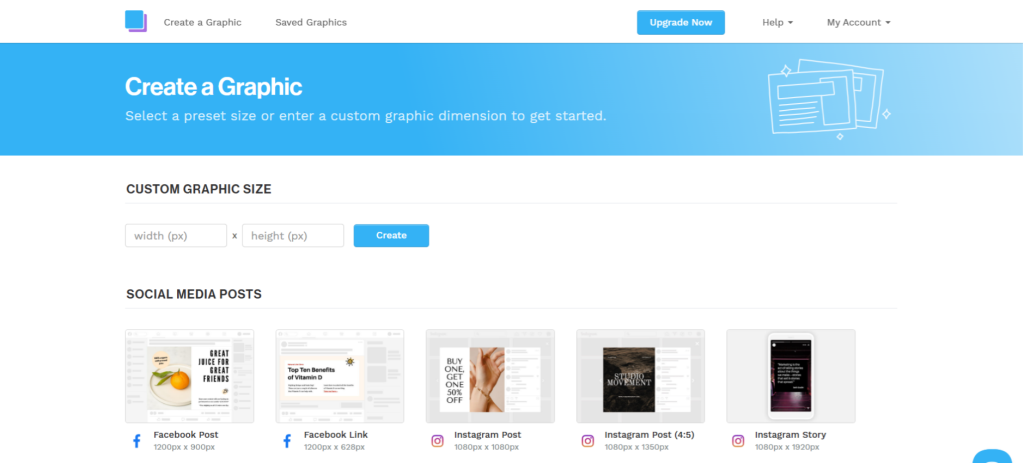
Within the editor, the customization options are pretty basic and simple. When we navigated through the design elements, we found that the drag-and-drop functionality is limited. The tool can extend it to replace pictures within the canvas.
Canva
Canva’s user interface is vibrant, featuring a wide range of features and templates. When comparing Snappa vs Canva, you may find Snappa to be more clunky if you are looking for a simple design tool. Otherwise, Canva is much more diverse in terms of functionality, document types, and caters to various kinds of users.
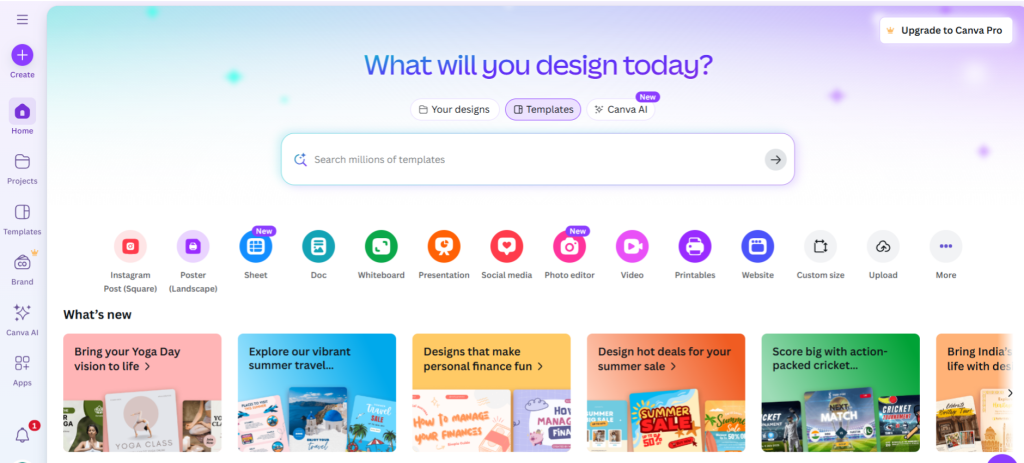
Despite offering a vast variety of assets and features, designing is smooth with Canva. You can search for templates and assets to find the designs you need. However, you may need to scroll through paid and free designs with the free plan.
DocHipo
DocHipo’s interface is clutter-free and easier to navigate when compared with both tools. The tool feels more organized due to the categorization of templates and design assets. Plus, you can also search for any design as soon as you land on the all templates page.
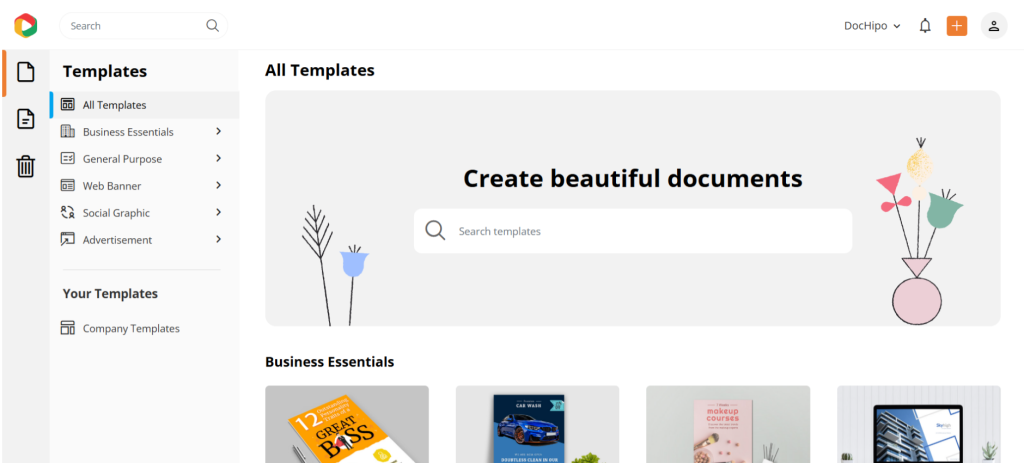
Within the editor, you will also find organized design widgets on the left panel for icons, stickers, pictures, charts, and more. Unlike Canva and Snappa, DocHipo hits the sweet spot with a streamlined design journey, right from finding templates to auto-saving them in one place.
Templates: Quality, Category, and Aesthetics
After exploring the interface, let’s delve into the templates library, comparing Canva, Snappa, and DocHipo. We have focused on the variety of templates, their design aesthetics, as well as their suitability for various use cases.
Snappa
Snappa primarily caters to web-based documents for social media platforms, including Instagram, X, LinkedIn, Facebook, YouTube, Pinterest, email, and Zoom backgrounds. But that’s not all. The tool also includes some rare online platforms such as Twitch and SoundCloud.
Furthermore, it also covers numerous templates in various advertisement formats, such as wide skyscraper ads, filmstrip ads, pushdown ads, billboards, etc. The best part is that you can customize any template, even with the free plan, but you can only download three.
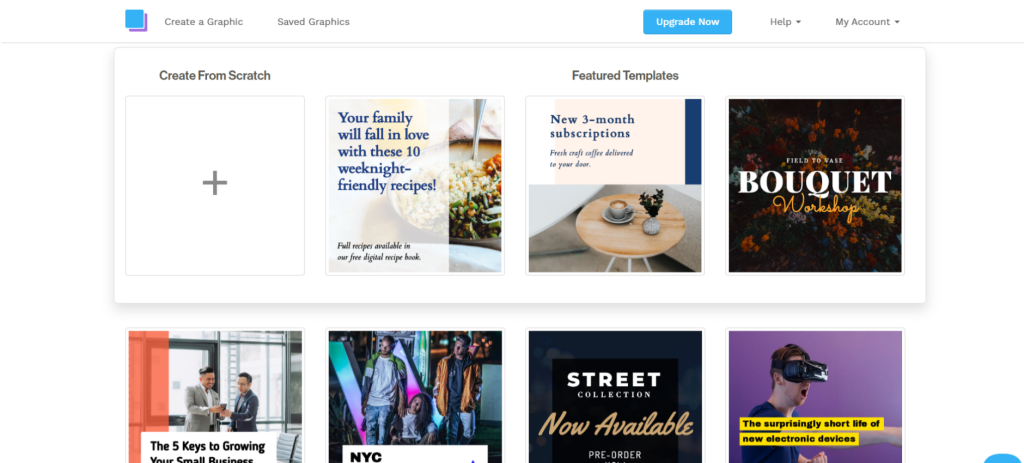
Regarding the design aesthetics of the templates, they tend to lean towards modern and trendy layouts. If you are looking for professional, business-oriented designs, you may struggle to find a template that aligns with your purpose.
While Snappa offers templates with a simple design language, you may struggle to find a suitable design for high branding layouts. Also, the tool can introduce more polished designs, adding more depth and creative sophistication.
Canva
Canva offers a vast variety of template designs, ranging from printables and professional documents to social media graphics and advertisements. You can find every document type in Canva, whether for personal use or professional purposes. The designs are eye-catching with high-quality graphics and exquisite typography.
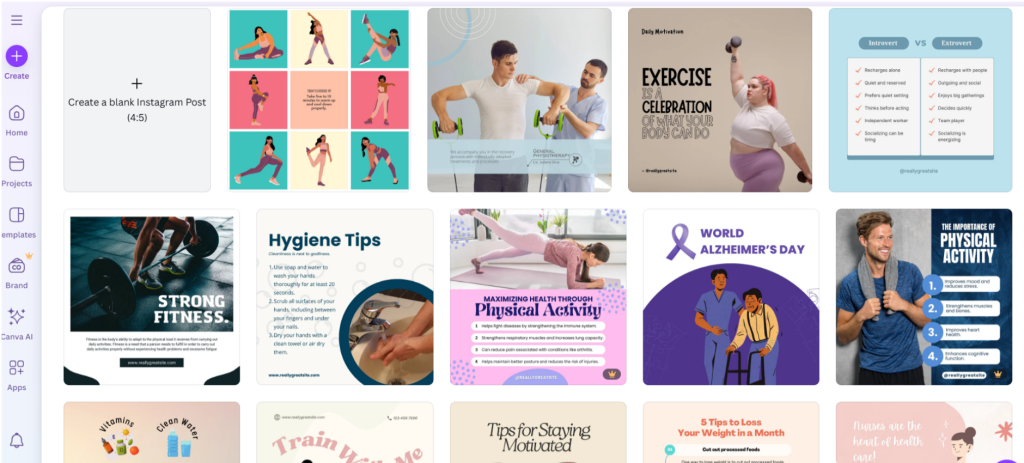
Speaking of design layouts, Canva offers a range from minimalist to retro, chic, and modern designs. However, the tool may not be suitable for somebody who does not want to scroll through a lot of designs. Additionally, with the free plan, many premium templates with better designs are not accessible.
Due to the popularity of Canva, it’s challenging to stand out with the templates. Thus, you may find it hard to stand out from your competitors. Moreover, the tool is quite restrictive with the free plan, as it introduces watermark issues when using the designs.
DocHipo
DocHipo design templates provide high-quality designs with easy accessibility. Unlike Snappa, DocHipo offers plenty of premium templates for printables like posters, flyers, brochures, case studies, resumes, menus, invitations, etc, along with social media posts, web banners, and advertisements. Furthermore, DocHipo also offers designs for carousels.
The tool is quite handy with its well-organized categories of templates. As soon as you search for templates, you can explore all the related document types within the drop-down menu. Afterwards, as you explore the various template layouts, you can easily sort them out with precise categorization.

That’s not all. For every document type, you can find two separate sections: one showcasing free templates and the other featuring premium ones. What we loved most is that DocHipo eliminates the hassle of watermark issues, even when used for free.
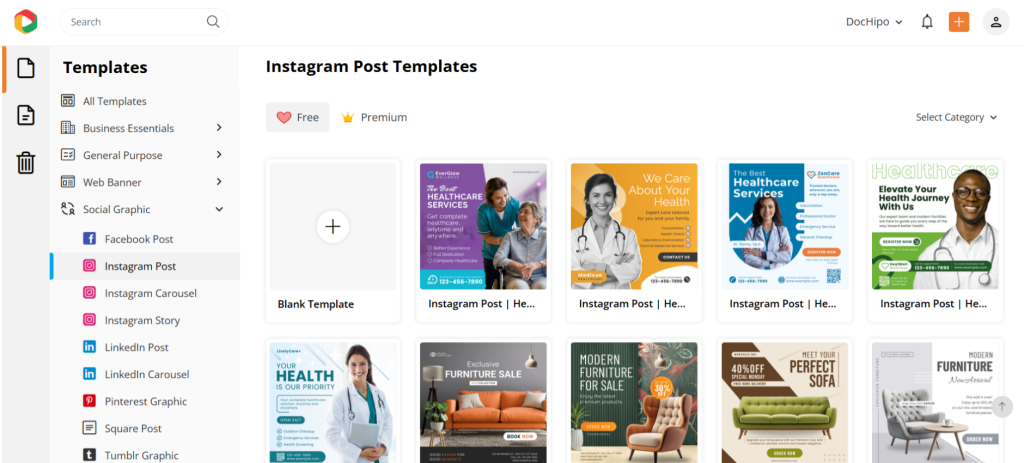
DocHipo offers business-driven designs with professional layouts with clean and modern aesthetics. It has an ever-growing template library catering to all types of marketing collaterals for both product-based and service-based businesses. Every template design is full of life with attention to detail and catchy visuals.
Design Assets: Snappa vs Canva vs DocHipo
Now, let’s explore what type of design assets all three tools offer to enhance your designs.
Snappa
Snappa offers all the basic design assets, such as shapes, icons, vectors, and stock images, to help with quick design. You can find everything under the Graphics option. Within the vector option, you can find a variety of different types of monochrome assets like stickers, abstract shapes, line art, etc. You can simply search the asset and pick a design from several options.
With icons, you can use colorful as well as monochrome design assets. However, you can only change colors for monochrome icons and vectors. One of the interesting features is that you can save any design asset and stock image as favorites for quick access.
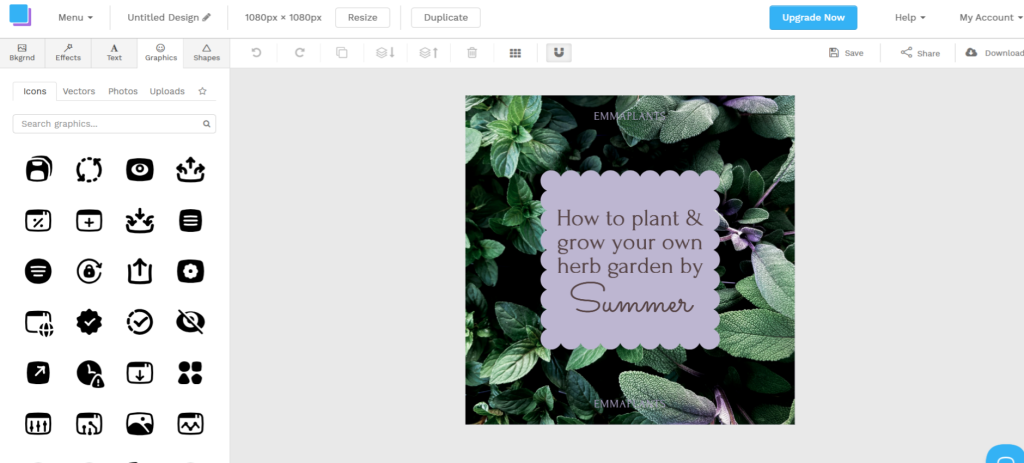
Snappa keeps designing simple with basic assets and minimal customization. However, the tool can enhance the experience with filters and categories to simplify search. Also, the tool can introduce a bit more variety within the design assets library with illustrations, text boxes, animations, charts, tables, etc.
Canva
In comparison to Snappa, Canva offers a lot more when it comes to design assets. Within the ‘Elements’ option, you can find everything from vectors, images, shapes, sheets, to charts, tables, and mockups. The assets are present not just for various themes and purposes but also in a variety of art styles.
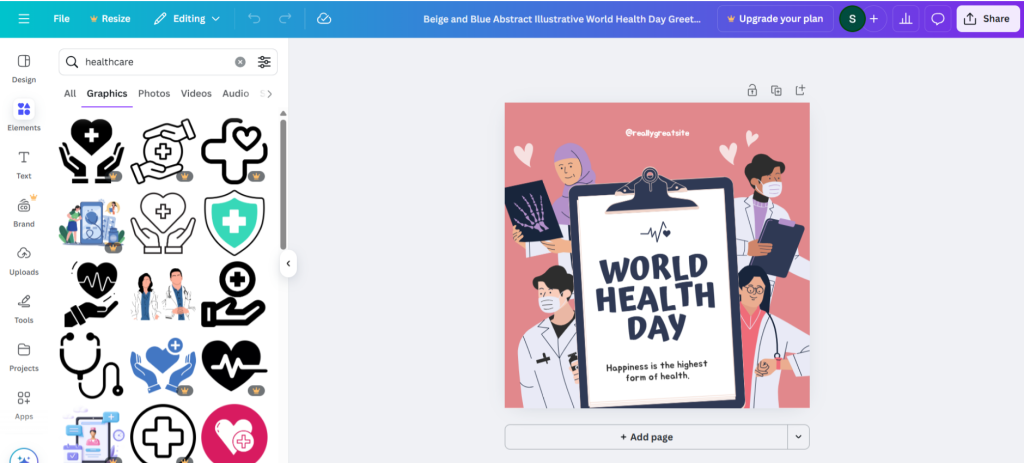
Unlike Snappa, you can search for the graphics and filter them based on orientation, color, and animation. However, with the free plan, you can access minimal assets, as many of them are behind the paywall. Once you choose an asset, you can customize its color, size, orientation, and transparency.
DocHipo
If you want high-quality and diverse graphics for your documents, you can opt for DocHipo. It offers a library of design widgets, including shapes, color and mono icons, stickers, solo and scene illustrations, text frames, animations, etc. What sets DocHipo apart from Snappa and Canva is the categorization of assets.
For instance, you can easily navigate through different geometrical, abstract, and ornamental shapes. Moreover, you can find graphics with well-organized and niche-specific categories like animals, business, education, food, healthcare, hobbies, occasions, etc. Here is a glimpse of the categories of vector icons for a better understanding.
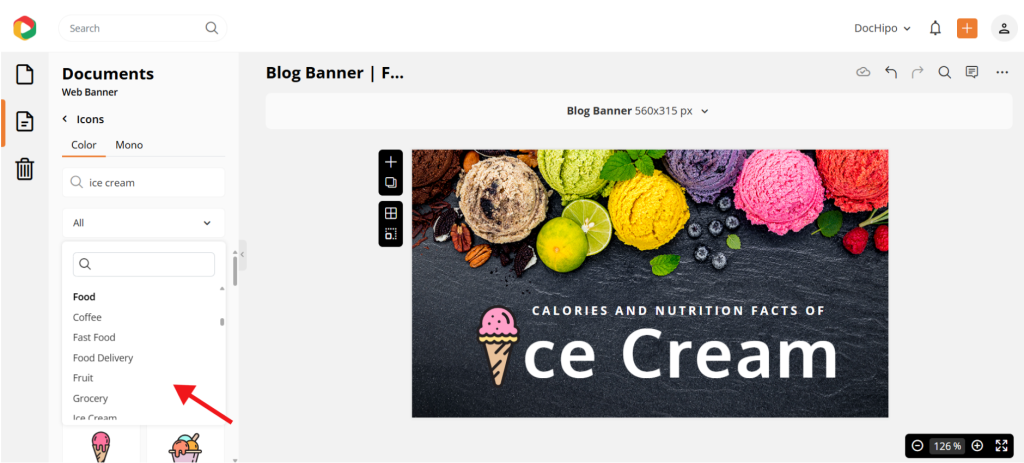
DocHipo illustrations also include various categories related to business, themes, industries, lifestyles, animals, etc. Unlike Snappa and Canva, DocHipo’s illustrations library also comprises culturally rich and inclusive themes as they aim to capture the minor intricacies of the countries, cultures, occasions, art forms, or ethnicities. Even the text frames portray exquisite designs featuring style, seasons, and a wide range of occasions.
Customizing the design assets is a breeze with DocHipo. You can change color, add shadow, blur effect, change opacity, animate, and arrange them on the canvas.
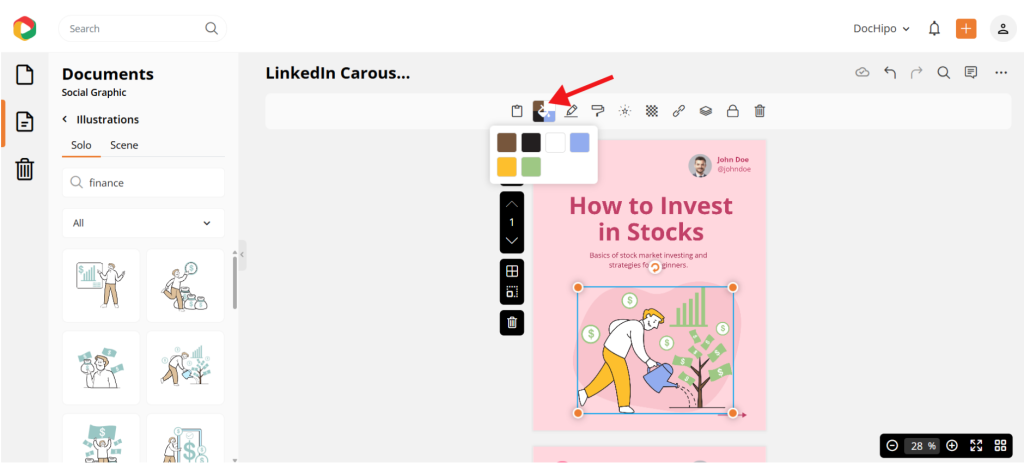
Also, you can get a variety of free stock images and videos to make rich content. Finding suitable pictures is easy with DocHipo, as you can search images and filter them based on color and orientation.
Overall, DocHipo satisfies all the basic needs for design assets with a lot of variety and flexibility to customize them.
Data Visualization: Canva vs Snappa vs DocHipo
Snappa does not offer built-in charts and graphs for data visualization. Instead, you can use Canva and DocHipo to turn monotonous data into captivating visuals. While Canva offers diverse charts, DocHipo offers charts and interactive maps. Let’s explore each of them.
In Canva, you can find charts within the Elements option and choose from a variety of different chart formats. The tool also allows you to import existing data sheets and turn them into desired visualizations. You can edit the data, X-Y axis, chart content, and color. Furthermore, you can set up line series and make the legends visible.
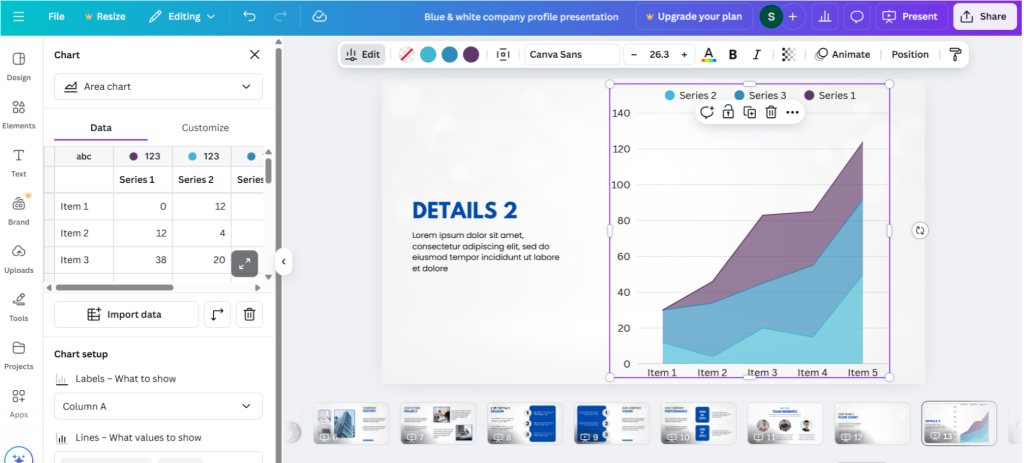
Like all the other sections, DocHipo creates a separate section for Data visualization that includes Charts and Maps. When you choose any of these options, you can customize the visuals in a separate window for a clutter-free design experience.
In DocHipo, you can find different types of charts, such as bar charts, graphs, area charts, pie charts, etc. You can customize the data and color within the sheet to make changes to the visuals. Moreover, in the Settings section, you can customize the axis, legends, fonts, captions, and more.
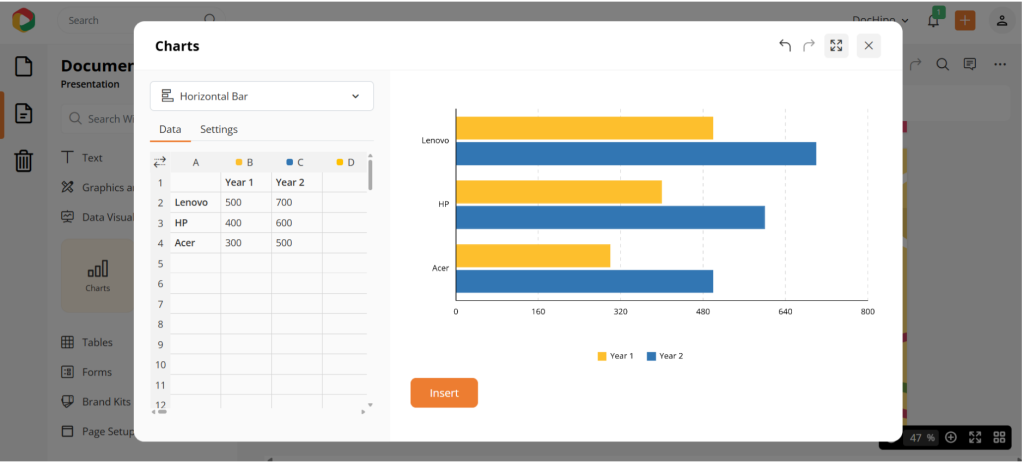
DocHipo’s integrated Maps are useful for geographical visualizations for different regions and countries. You can show legends, highlight areas, customize colors, and add captions.
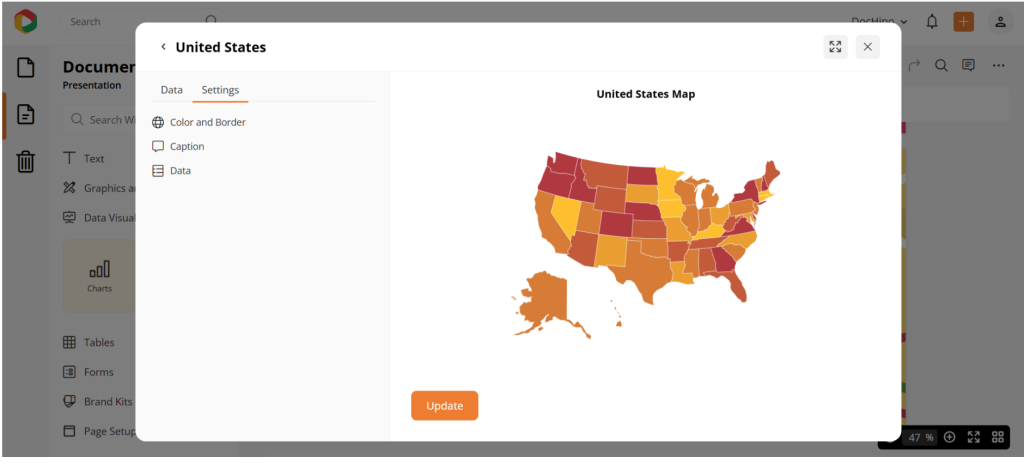
Core Design Features: Snappa vs Canva vs DocHipo
Now, let’s look at the core design features of each tool to explore the possibilities of designing.
Snappa
Designing in Snappa is relatively basic compared to Canva and DocHipo. The tool allows all the necessary customization of text and graphics. For text, you can change the font, color, spacing, alignment, and opacity. Furthermore, you can add a shadow and a blur effect too. Plus, you can upload custom fonts for the documents.
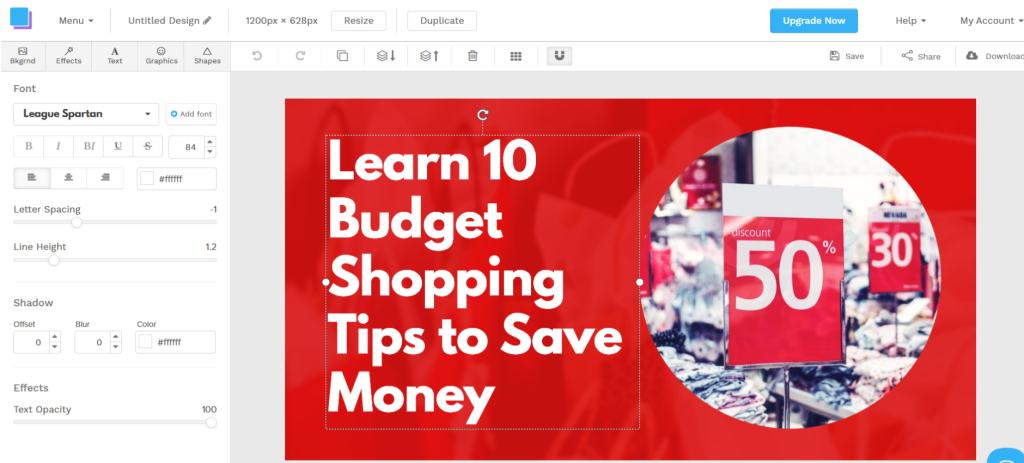
You can also add background photos, colors, and patterns. Moreover, you can add images to favorites. If you add the stock images, you can crop them into square, rectangular, and circular shapes only. Further, you can customize the orientation, opacity, and also remove the background.
Snappa also offers a document resize option so that you can repurpose the same design in seconds. Another interesting feature is the Toggle Safe Zone option that allows you to analyze where to place the most crucial elements in the design.
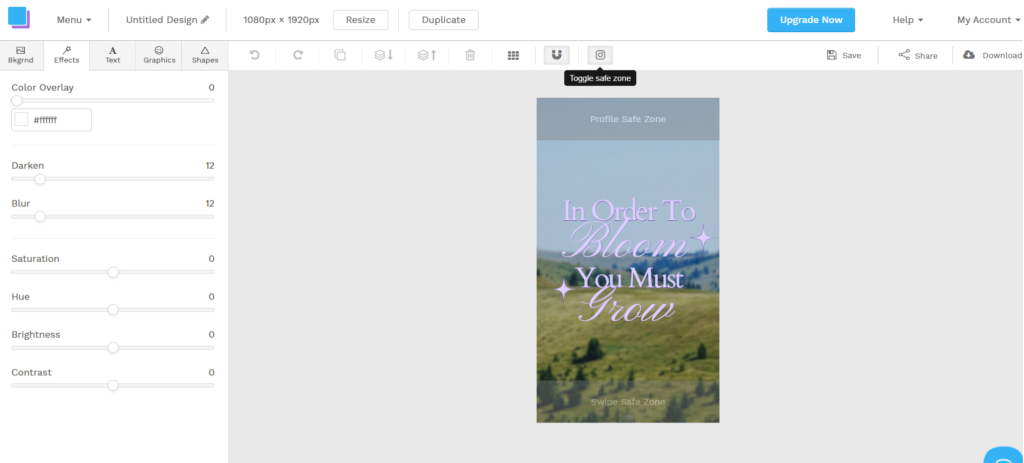
Although the app does not offer Brand Kit and Color Themes separately, it allows you to upload fonts, save colors, and graphics for quick access. You can also easily layer up or layer down any element within the canvas. However, Snappa can feel restrictive if you want to add or duplicate pages within the editor.
Overall, the tool brings the ease of quick designing for various platforms, but has a lot of scope to introduce some features like AI tools, animated effects, copy style, etc.
Canva
Canva offers plenty of design features that require some time to explore. You can bring basic text and graphics customizations like Snappa, but there is a lot more. For text customization, you can change font, color, size, and transparency. Also, Canva offers a variety of text and animated effects to make your text pop.
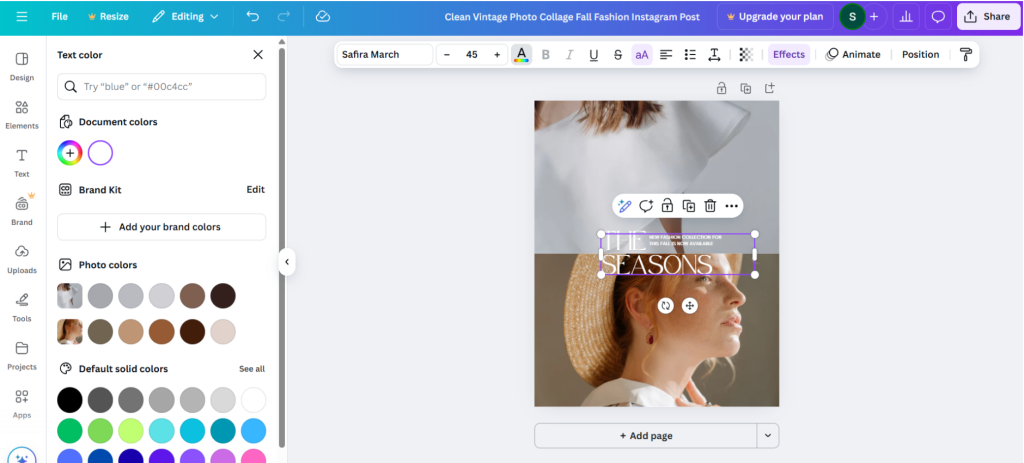
You can resize and change the position of all the graphics on the canvas. Canva’s strength lies in the advanced photo editing capabilities, which help you with layered editing of the foreground and the background elements. Moreover, the tool also offers video editing capabilities.
Canva also lets you resize a document into any dimension. Another helpful feature is the PDF converter feature that allows you to convert any document into a PDF and edit it. With Canva, brand management is easy, as you can save your brand logos, fonts, colors, charts, etc, in one place. You can also pick color themes from Styles to change the entire layout of the document.
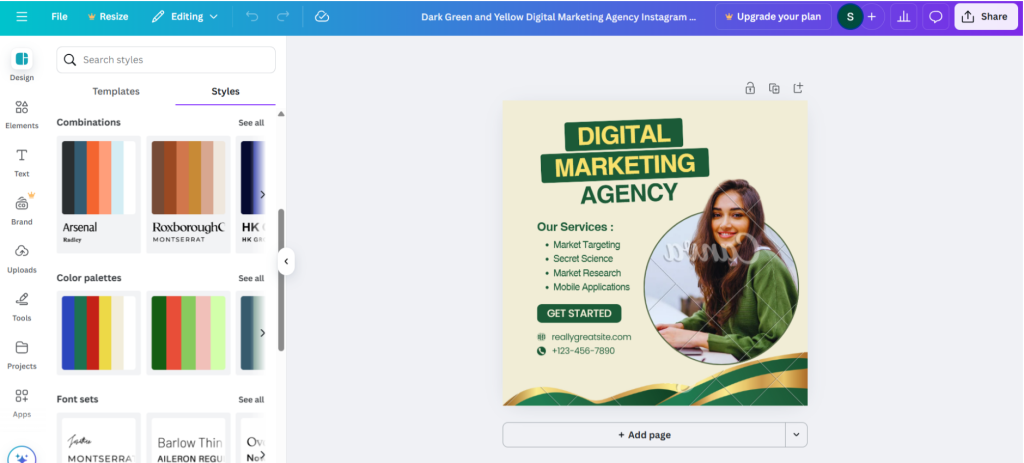
Apart from designing, Canva also offers a scheduler and insights into market performance.
DocHipo
If you are looking for a tool with a hassle-free interface yet robust core design features, DocHipo is your go-to tool. It stands somewhere between Snappa and Canva as it offers easy-to-use features, enabling quick design, but also eliminates the complexities of Canva.
DocHipo offers text customizations for size, font, orientation, color, etc, along with effects like animations, shadow, blur, and outline. Moreover, you can upload Custom Fonts to the editor to personalize your designs.
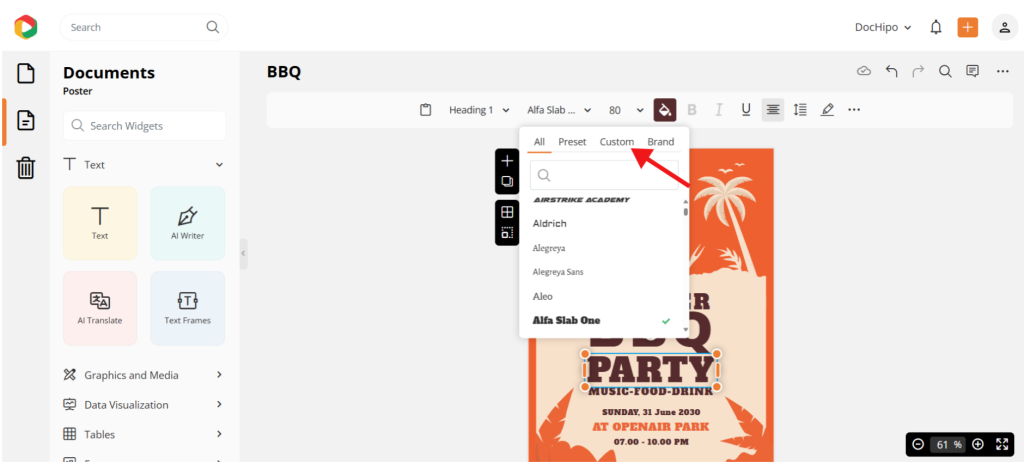
In addition, you can create photo collages and QR codes for your documents with ease. The tool is well adept with photo editing capabilities like crop to different shapes, filters, and tonal adjustments like contrast, brightness, blur, saturation, etc. Unlike Snappa, it also offers a built-in video trimmer tool for video editing.
When it comes to color customizations, you can pick a color with the color dropper or apply solid, gradient, and transparent colors to text and shapes for a unique effect. One of the interesting features is the way DocHipo offers Color Themes. You can pick a theme based on occasion, mood, color, nature, and more.

DocHipo’s well-thought-out categorization helps with quick designing at every step. The options include Arrange, simplify layered editing, where you can rotate and place the elements with precise angles and positions. Other simple features like Copy Style help you to copy the style from a widget, like text, icons, illustrations, stickers, etc., and apply it to another widget of your choice with just a click.
The tool also takes care of your brand assets with the Brand Kit, saving all your logos, fonts, colors, and graphics. You can also save your signature designs with the Company Templates feature for easy access by your team.
The tool also allows you to resize documents into ideal document sizes or a custom size. Also, accessing saved designs is easier with the filters based on date, document type, file name, etc, which we did not find in Snappa.
Sharing and Downloading Options
All three tools offer real-time team collaboration but differ in their functionality. With Snappa, you can only share projects when you save them, as there is no auto-save feature within the tool. On the other hand, Canva and DocHipo allow collaboration right within the editor, where you can control access and share views via chat.
You can also publish designs to various social media platforms with all three tools. Snappa allows you to share directly to Buffer and other social media platforms, including Facebook and X/Twitter. Canva covers a wide range of sharing capabilities, including QR code sharing.
DocHipo offers access control publishing on various platforms, allowing you to set a password or enable download access.

While comparing the downloading formats, we found that Snappa allows only JPG and PNG formats. Canva and DocHipo support a wide range of formats, offering PNG, JPG, PDF, MP4, GIF, etc.
AI Capabilities: Snappa vs Canva vs DocHipo
Snappa does not offer a full-fledged AI generator, but it does include a background remover for pictures. If you are looking for advanced AI capabilities, Canva and DocHipo are more suitable options.
With Canva AI, you can generate designs, images, videos, draft a doc, or code for you with text prompts. The Magic Write tool allows you to create any type of text copy for your designs. In addition, the Magic Studio will enable you to upscale images, remove backgrounds, remove objects, expand and grab, transforming your pictures entirely.
DocHipo also offers generative AI capabilities for images and text. With DocHipo text-to-image generator, you can describe the image with a prompt and also select a suitable Style such as 3D, animated, illustration, logo, oil painting, watercolor, realistic, cinematic, etc.
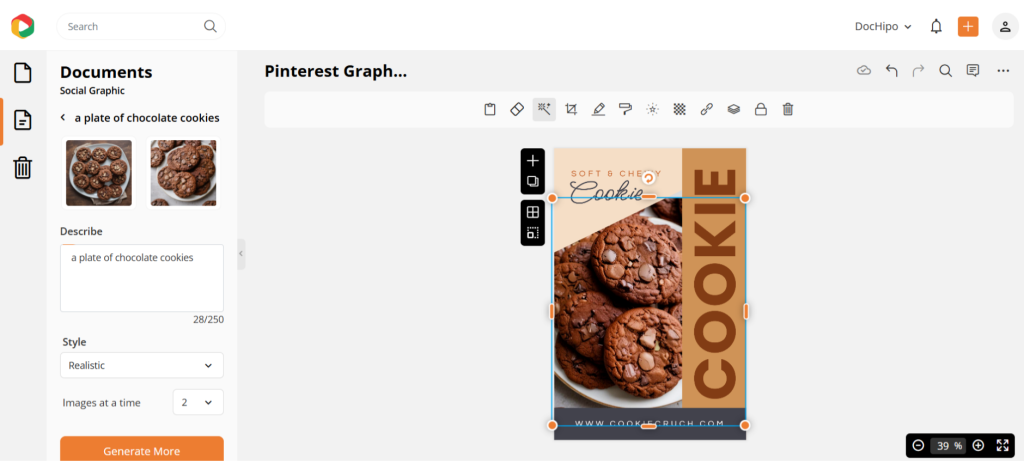
Moreover, you can also remove the background of any image with just a click.
You can also generate text for blogs, copy, ideas, captions, keywords, and outlines with DocHipo AI Writer with simple prompts, and also choose the Tone of the text like professional, casual, friendly, confident, etc. Furthermore, you can translate your documents into over a hundred languages with AI Translate.
Apps and Integrations for Seamless Workflow
Integrations with other party apps enhance interconnectivity and streamline workflows. Let’s explore integrations comparing Canva vs Snappa vs DocHipo.
Snappa
Snappa offers stock image integration with Pexels for high-quality photos. Apart from that, the tool also integrates with Buffer to directly schedule social media posts for the designs created within the tool. If you use both Snappa and Buffer, the integration can save time without switching between them.
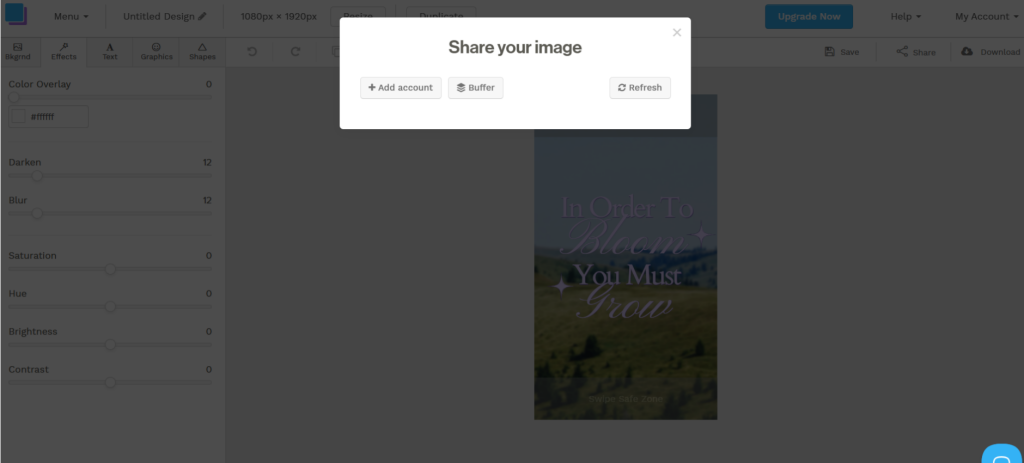
Snappa’s integration with popular cloud storage services, such as Google Drive and Dropbox, further enhances workflow efficiency.
Canva
Canva offers plenty of integration options for various purposes. To streamline workflow with teams, Canva integrates with Slack, Asana, Google Workspace, Teams, etc. It also integrates with some resourceful tools like Google Sheets, Google Analytics, and HubSpot to keep everything connected.
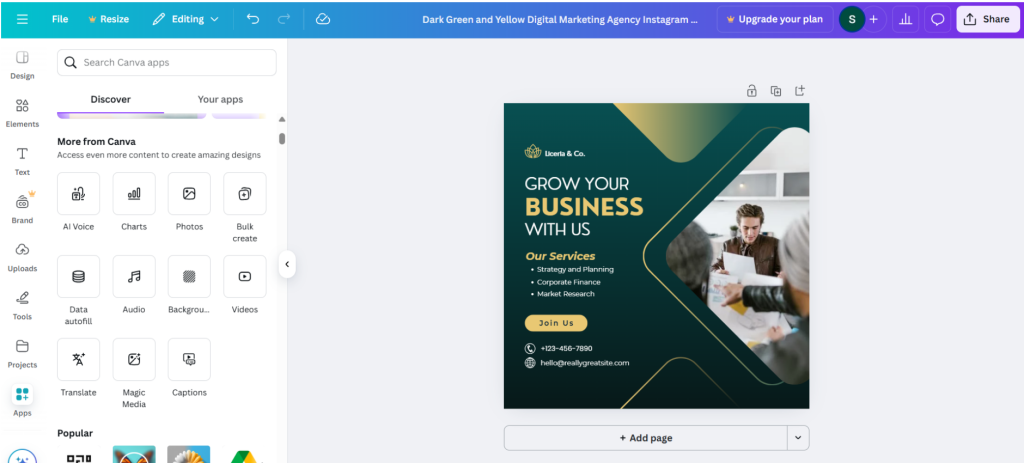
There are many apps to help you customize designs within Canva. Apps like Colorize Image Upscaler help with basic customization processes. But there are over 300 design apps to streamline creative workflows, including Mockups, Brandfetch, Typecraft, and Dynamic QR codes.
DocHipo
DocHipo integrations focus on streamlining design creation, sharing, and collaboration for businesses. For stock images, the tool integrates with Pexels and Unsplash to bring top-notch quality for your documents. It also includes stock videos and YouTube integration to give a dynamic appeal to your designs.
Furthermore, DocHipo also integrates with Jotform and Typeform. You can embed them into your documents to generate more leads, gather feedback, or collect client information.
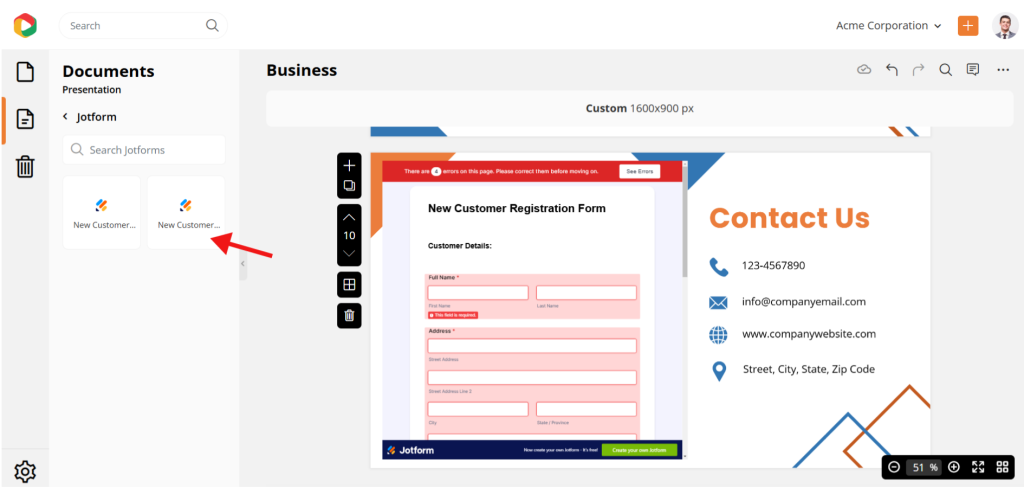
Apart from that, you can also streamline your email marketing with the MailChimp integration. For AI capabilities, DocHipo integrates with OpenAI, Stable Diffusion, and Google Translate for the best results.
Pricing: Snappa vs Canva vs DocHipo
Let’s check one of the most crucial aspects – the pricing of all three tools.
Snappa
Snappa offers a free plan where you can design with any template or design asset for as long as you want. However, if you’re going to consider the tool in the long run, you can access all the features with these paid plans:
- Pro Plan: $10/month per person, billed yearly.
- Team Plan: $20/month per person, billed yearly.
Canva
Canva also offers a free plan with limited templates and design capabilities. You can access all the templates and assets with these paid plans:
- Canva Pro: $120 per year per user.
- Canva Teams: $300 per year for a minimum of three users.
- Canva Enterprise: Custom pricing.
DocHipo
DocHipo allows you to access free templates and assets with the free plan. However, you can gain complete access with these paid plans:
- Pro Plan: $ 7.5/month per user, billed annually. It is ideal for solopreneurs and small teams who need pro tools for advanced document design.
- Pro Unlimited: $225/month for unlimited users. Large teams should design professional documents with advanced tools.
Suitability: Canva vs Snappa vs DocHipo
After considering the features and pricing of the three tools, here is a concise table depicting the suitability of each one of them.
| Tools | Suitability |
| Snappa | Snappa is suitable for solo content creators and non-designers who need quick and casual web designs. |
| Canva | Canva caters to marketers, educators, business teams, and creators, creating a wide variety of content. |
| DocHipo | DocHipo is best for solopreneurs, small business owners, freelancers, and creators who need to create on-brand, business-ready documents quickly. |
Watch this video to know all about getting started with DocHipo.
Final Verdict for Snappa vs Canva vs DocHipo
Now, we have come towards the end of the comparison blog. We have nitpicked on every feature to assess the tools, and here is our final verdict.
Snappa is excellent for quick designing with social media-oriented designs. You can use it even with no experience in designing and create designs with your team. However, it may not be suitable for someone who wants to create printables and strictly professional designs.
Canva is quite versatile with lots of features to offer. It might take some time to get the hang of all the features, but it is the one-stop destination for designing, scheduling, and analyzing. However, it might not be the most affordable option for you if you are looking for a tool with a focused use case.
DocHipo hits the sweet spot, somewhere between the two tools. It’s quite simplistic like Snappa, along with advanced features, but never gets too complicated like Canva.
If you are looking for a design tool that caters to business-ready designs that drive results, DocHipo can be the most affordable option. Plus, the interface is clutter-free with a smooth design experience to create on-brand documents. Sign up with DocHipo today and streamline your design workflow.
FAQs
Is Snappa or Canva better?
Canva offers more template categories, assets, and integrations for its users. On the other hand, Snappa offers quick and easy design creation without being overwhelmed with options, but it has limited design capabilities.
If you are searching for another tool that brings simplicity like Snappa but retains the advanced features, you can give DocHipo a shot.
Is Snappa completely free?
Yes, Snappa is entirely free to use and design. However, the free plan offers limited capabilities and downloads.


